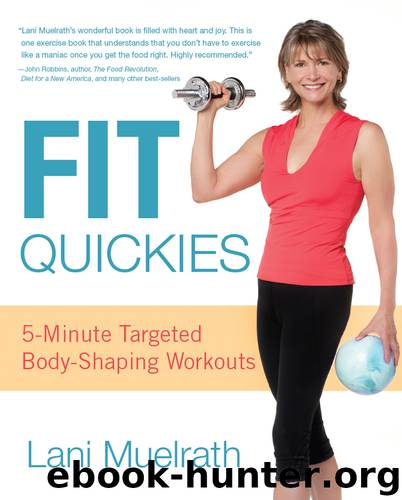Fit Quickies by Lani Muelrath

Author:Lani Muelrath [Muelrath, Lani]
Language: eng
Format: epub, mobi
ISBN: 9781615644063
Publisher: DK Publishing
Published: 2013-02-04T16:00:00+00:00
The Problem
The calf muscles are largely underused and often out of play for several hours a day while we sit at desks and workstations, and in cars, trains, and airplanes. This has serious implications for your circulation. (More on this coming up.) The calves are also the first place you should get active when you need to warm up for exercise, stimulate circulation, or just plain get invigorated.
Knee stability is largely a function of the soft tissues surrounding it—tendons, ligaments, and discs made of cartilage. These tissues form intricate connections and work as a team to stabilize your knee.
Perhaps your knees just aren’t what they used to be. Maybe you’re looking for a way to stabilize them without putting them into a compromising position. It’s possible that even just the thought of bending your knees makes you wince. Although this might sound like a knee problem, don’t forget that the muscles in your legs that run up to, down to, and through and around your knees play a complex role in the integrity of your knee joints. That includes your calf muscles, which is why calves and knees are worked together in this exercise.
The Facts
The knee is a very complex joint—and one we demand a lot of. Given that your knee is also smack dab in the middle of your longest limbs, your legs, you can see how it’s susceptible to trouble.
Knee joint motion occurs in several directions and has multiple biomechanical functions. Take the simple act of walking, for instance. During the standing phase of walking, your knees stay slightly flexed to act as shock absorbers and to transmit forces through your lower legs. As your leg swings through on your stride, your knee flexes to shorten your leg so your foot can clear the ground on swing-through. The load on these functions becomes even heavier when you pick up the pace in a run.
Add to that the face that variations in knee alignment—from knock-knee to bow-leg and all points in between—are not uncommon, and you can see how you can easily encounter pain, injury, and other problems at the knee joints. And what about lateral movement demands, such as side-to-side action on the tennis or basketball court or the dance floor? Any way you put it, the stability challenges placed on your knees are enormous. No wonder knees are so susceptible to injury. Your knees need your tender loving care, and your calves are there to come to the rescue.
Your knees employ an entire fleet of shock absorbers and friction reducers in the form of bursa sacks —14 of them!—and fat pads. Bursae release synovial fluid, a clear fluid secreted by membranes in joint cavities to lubricate the knee joint. Bursae can be injured by trauma, which leads to inflammation of the bursae called bursitis.
In addition, the flow of lymph from your legs toward your heart is the result of the pumping action of your calf muscles at work. This pumping action also circulates used blood from your lower legs up against gravity back to your upper body for refreshment and reoxygenation.
Download
This site does not store any files on its server. We only index and link to content provided by other sites. Please contact the content providers to delete copyright contents if any and email us, we'll remove relevant links or contents immediately.
The Body: A Guide for Occupants by Bill Bryson(4973)
Audition by Ryu Murakami(4840)
Adulting by Kelly Williams Brown(4484)
Housekeeping by Marilynne Robinson(4328)
Be in a Treehouse by Pete Nelson(3941)
Zero Waste Home by Bea Johnson(3777)
Seriously... I'm Kidding by Ellen DeGeneres(3574)
Better Homes and Gardens New Cookbook by Better Homes & Gardens(3523)
The Healing Self by Deepak Chopra(3473)
Barkskins by Annie Proulx(3298)
Hedgerow by John Wright(3273)
The Cellar by Natasha Preston(3259)
Spark Joy by Marie Kondo(3246)
The Genius of Japanese Carpentry by Azby Brown(3223)
The Life-Changing Magic Of Tidying Up- The Japanese Art Of Decluttering And Organizing (v5.0) by Marie Kondo(3211)
120 Days of Sodom by Marquis de Sade(3176)
Work Clean by Dan Charnas(3048)
The Book of Numbers by Peter Bentley(2907)
A Monk's Guide to a Clean House and Mind by Shoukei Matsumoto(2866)
